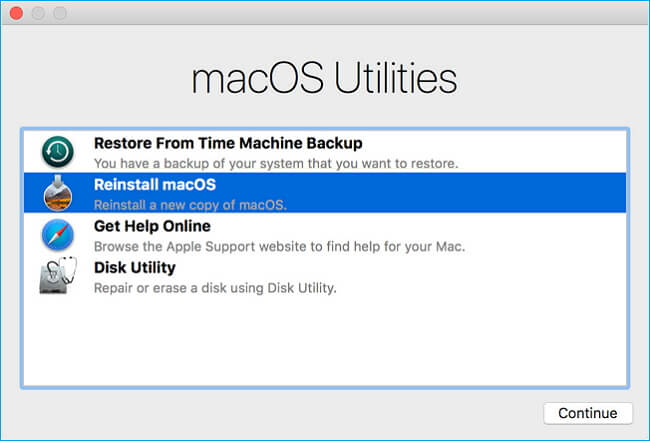Does Reinstalling macOS in Recovery Mode Delete Everything on Mac
Jean updated on Feb 14, 2025 to Mac File Recovery | How-to Articles
macOS Recovery helps you easily reinstall the Mac operating system on your built-in drive or an external drive. This blog answers 'Does reinstalling macOS delete files?' Besides, it also suggests using EaseUS Data Recovery Wizard for Mac to recover lost and deleted files.
This page illustrates the detailed process of recovering data from a failed Mac computer before you reinstall the macOS. If you are having the same issue, follow through this page to see how to get data out of the failed Mac computer before macOS reinstallation:
"My macOS Catalina got corrupted, and the login screen doesn't appear. If I reinstall macOS from the recovery menu, will my previously installed software and data be deleted? And if so, how can I back them up on a hard drive? The data and the software are very important to me."
Reinstalling macOS of macOS Recovery can help you replace the current problematic OS with a clean version quickly and easily. Technically speaking, simply reinstalling macOS won't erase your disk or delete files. You probably don't need to erase unless you're selling or giving away your Mac or having an issue that requires you to wipe. Besides, If you suspect there's something wrong with your startup drive, you can use the Disk Utility to scan and repair them from the recovery screen, which might be a quicker and more convenient alternative than erasing and reinstalling your macOS.

If you're encountering the same issue as said at the beginning of the article, your computer gets corrupted, and you have to consider a complete restart in Recovery Mode. At this time, you need to use the Disk Utility in macOS Recovery to erase your Mac hard drive first and go on to reinstall the macOS.
As we all know, erasing the hard disk on a Mac will inevitably cause data loss and make the files unrecoverable. You can use EaseUS Data Recovery Wizard for Mac Pro to back up data first and then recover data from the backup.

Back Up Your Mac and Never Lose Data
Back up and restore your MacBook/iMac without Time Machine, iCloud, or external hard drives.
This software enables you to create a bootable USB drive on another Mac that works well, then restart your Mac from it, and go ahead to recover files. Especially to restore data on the system drive under macOS 10.13, it's very safe to recover from bootable media. Useful for any emergency, no secondary data damage!
Now, follow the step-by-step guides below to see how to recover data from Mac that fail to start and needs to erase and reinstalled OS. The tutorial will be divided into two parts: how to create a USB bootable media and recover data from bootable media.
If you don't know how to create a USB bootable isntaller, the easiest and most effective way is to use a tool. EaseUS Data Recovery Wizard for Mac provides a free macOS installation feature to help users install new or old macOS from an external hard drive smoothly! Check out the following steps:
Step 1. Select a macOS version
Select a macOS version from the list, or click the "Refresh" option to get the downloaded macOS version. Or you can add a macOS installer from your disk by clicking the "Add" button. Insert a USB flash drive larger than 16 GB to save the macOS installer.
Step 2. Erase the USB flash drive
After choosing the USB flash drive, click the "Erase and create" option in the pop-up window to format your USB flash drive quickly, and then click the "Create macOS installer" button to continue.
Step 3. Create the macOS installer boot drive
Wait for the process to complete, and click the "Finish" button. Your macOS installer boot drive has been successfully created!
Step 1. Search for lost files
Select the disk location to search for lost files (it can be an internal HDD/SSD or an external hard drive) where you lost data and files. Click the "Search for lost files" button.
Step 2. Go through the scanning results
This software will immediately scan your selected disk volume and display pictures, documents, audio, videos, and emails on the left pane.
Step 3. Select the file(s) and recover
Click the data to preview, and click the "Recover" button to have them back.
After the data recovery, you can use the "Disk Utility" to erase your Mac disk and then choose "Reinstall macOS" to finish the reinstalling.
EaseUS Mac data recovery program allows you to recover deleted files from the emptied trash bin, internal/external hard drive, SSD, corrupted or formatted memory card, including memory sticks, SD cards, CF cards, XD & MMC cards. Besides, it also enables you to recover lost Word, Excel, PPT, etc.
Related Articles
No Available Time Machine Destinations | Fixed in Proven Ways
How to Clear DNS Cache on a Mac [Recovery Tip]
External SSD Not Showing Up in Disk Utility [Fix It Without Data Loss]
Recover Data from RAW SD Card on MacBook Air/Pro [4 Practical Solutions]